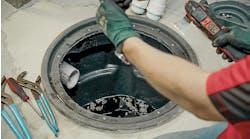You want to get out, but you don't know where to start. How much are the years of sweat equity and hard work worth? Will anyone look beyond the numbers? More than a few contractors spend decades looking forward to the day they cash out. That's good. But when they get an unwelcome surprise as they try to retire, that's not so good.
The biggest mistake contractors make is they don't know their numbers, how their company will be valued and what they can do to increase the value of their company. But if you're looking forward to a final big payday at retirement, doesn't it make sense to make the check as big as possible?
Here are some methods I use to value a business on paper and based on potential. If you're selling, there are considerations for getting the best price. Keep in mind, though, that building up your business as a nest egg for retirement works best if you have been making the right moves through the years to maximize profits and make your business an attractive acquisition candidate.
There are two concepts to think about when valuing a plumbing, HVAC or electrical contractor. One is the reality of the business, where an accountant or a business valuation expert would look first. The other concept is the opportunity, which is my primary focus.
Reality: the numbers
Reality boils down to multiples of earnings and EBT (earnings before taxes). Reality is what your business looks like in financial statements, typically for a period of three years, including the current year. This is what most business valuation people use to analyze a company. For example, let's consider “Charlie's Heating & Air Conditioning,” which is based on a company I analyzed. Charlie's was generating $300,000 a year in revenue at a 2% profit, for a profit of $6,000 before taxes. This did not include the $52,000 a year in wages he paid himself. Charlie's EBT is $6,000.
An accountant would then add to that figure any expenses that would not be incurred after the sale, such as Charlie's $50 per month life insurance premium. So, you're adding $600 ($50 x 12 months) back into profit. On paper, Charlie's is producing $6,600 a year in profit. Once you know that value, accountants will typically multiply that amount three to five times to determine a value for the business. In Charlie's case, using this valuation method, his business is worth $19,800 to $33,000, plus the wholesale market value of Charlie's assets.
Opportunity: the potential
When I analyze the value of a contractor's business, I focus on opportunity. I'm not that concerned with the profit. I don't care what assets they have except what the market value is. Their liabilities, if I assume them, will affect my valuation. I focus on one thing: how often the phone rings for service. The opportunity is how many calls are coming into that business and what I can do with them.
A business running four, eight or 12 service calls a day and underperforming is an opportunity for a turnaround. Charlie's was running at least eight service calls a day. The company wasn't worth much in reality, but I saw opportunity.
I knew from experience that if I had just four calls a day, I could generate $447,200 annually in service and replacement revenue per truck. Eight calls and two service trucks could generate at least $900,000 in service and replacement revenue with a net profit of 18%, not including the general manager's salary. Those numbers are based on formulas and business operating systems used by Benjamin Franklin Plumbing, One Hour Heating & Air Conditioning and Mister Sparky franchises across the U.S.
The right processes can help turn around a failing business, and as a first step, they offer a benchmark for the amount of business you should be doing. Sadly, contractors like Charlie sometimes work all their lives and when it comes time to retire, they think their company is worth a lot of money. In Charlie's case, he wanted to sell his company for $150,000, but couldn't find a buyer. I bought Charlie's company for assets, plus $50,000; implemented the systems I talked about; and turned the company into a $970,000 profit-making machine in only 26 months.
“I wish I'd have known about these business operating systems 38 years ago when I started my business,” Charlie said later. “I'd be a wealthy man today.”
My point here is for you to implement a system that works sooner, not later. Plan for the day you retire by running your business correctly, so you receive maximum value when you cash out.
Once you've put a value on your business that you're willing to accept, the hard part is finding someone to pay your price. Where do you turn? Options may include family, friends, venture capital firms, competitors, consolidators and employees. Each presents different challenges.
If your business is your retirement plan, put a system in place to run your business well, review the numbers often and prevent unwelcome surprises later. Make sure your final payday for years of hard work is a big one.
Lon Cassel is president of Wealth Now Group, a division of Clockwork Home Services Inc. He specializes in mergers and acquisitions of HVAC, plumbing and electrical companies. He may be contacted at 866.574.7431, ext. 456.

